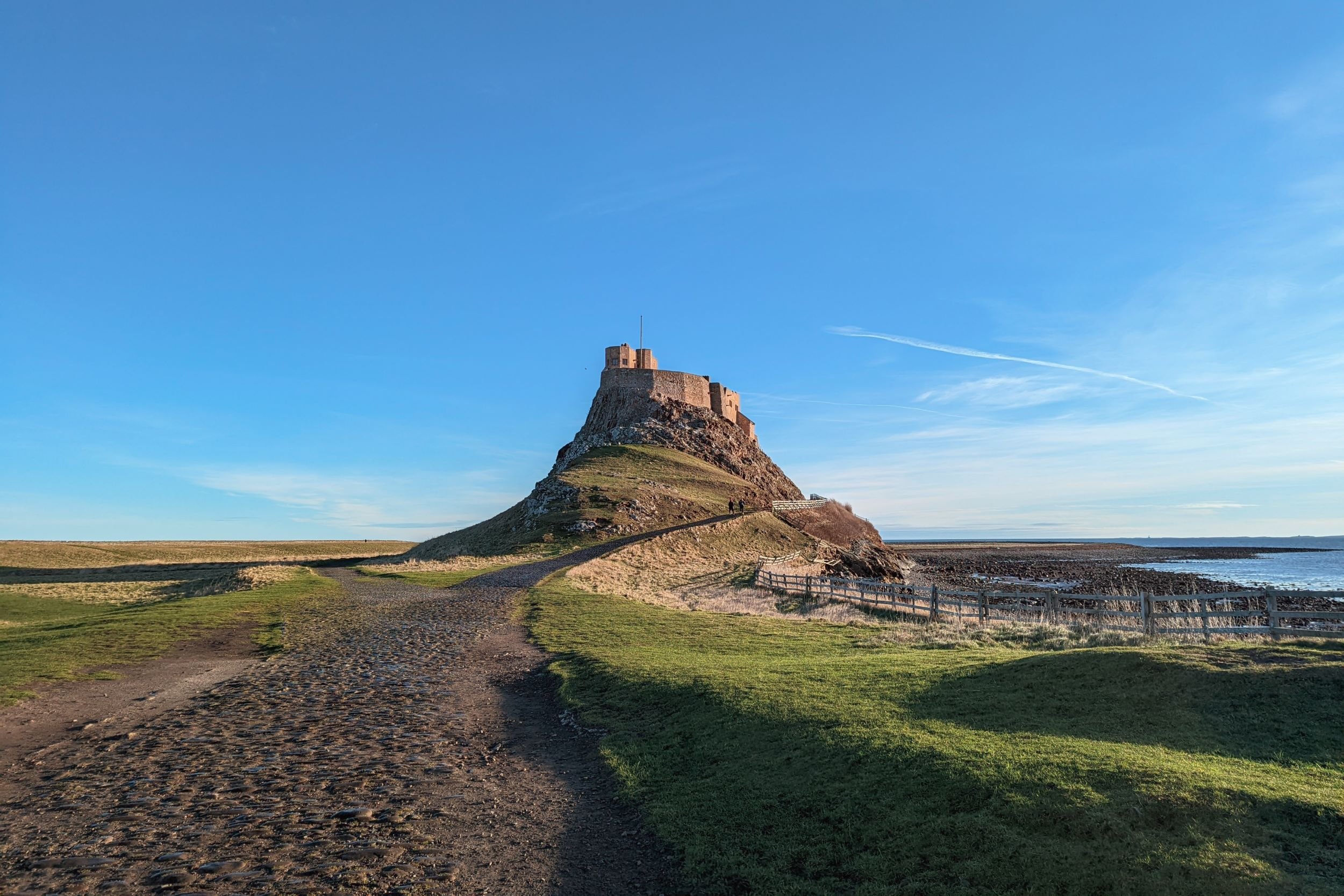
Lindisfarne
Visitor Guide
Lindisfarne: A place of pilgrimage … once for Christians now for tourists
A tidal island off the coast of Northumberland, only accessible at low tide, where you can visit a 16th-century hilltop fortress converted to an Edwardian country house, the ruins of a thousand-year-old monastery, a Gertrude Jekyll garden, and a Viking museum.
Lindisfarne ©Mark Elliot CC BY 2.0
The National Trust describes Lindisfarne as a castle that's not a castle on an island that's not an island. These contradictions neatly capture our feelings about visiting Holy Island.
The best thing about the Northumberland coast is that it is neither as busy nor as touristy as other Areas of Outstanding Natural Beauty. Lindisfarne is the one exception. It is both busy and touristy, even out of season. However, we would still recommend a visit.
We went and braved the crowds because at my school, that's where British history started. "793, Viking raid on Lindisfarne," my favourite school teacher declaimed, without preamble, in a broad Lancashire accent, in the first sentence of the first lesson. Visiting gives you a feel for Holy Island's place in British history and its importance to early Christians and to Britons in their skirmishes with the Scots.
Once there, we discovered other charms…
Why is Lindisfarne worth visiting?
To stop off at the best beach in Northumberland.
For the approach to the island across the causeway.
To visit the ruins of the priory and its museum to learn about the island's history.
You can see the "castle that's not a castle" and its walled garden, created by two of the biggest names in early twentieth-century design.
Enjoy the views of a unique coastal environment.
Ross Back Sands ©Mosey Travel
Lindisfarne Priory ©Mark Elliot CC BY 2.0
Holy Island Causeway ©Ian Capper CC BY-SA 2.0
Lindisfarne Walled Garden ©Nairnbairn BY-SA 2.0
Lindisfarne View ©Mosey Travel
Things to do on Holy Island
1. Stop off at Ross Bank Sands
Ross Back Sands ©Mosey Travel
Ross Bank Sands (NE70 7EN) is just down the coast from Lindisfarne. It is the least visited beach in Northumberland and partly for that reason, in our opinion, the best.
Access is on foot, a twenty-minute walk across farmland and dunes. There is a small area for parking just before Ross Farm. Arrive early enough and there is every chance you will, as we did, have the beach to yourself.
The beach is about three miles long and is framed by views of Bamburgh Castle to the south and Lindisfarne Castle to the north. It looks like you can walk to both castles, but this is an illusion.
Guile Point is at the north end of the beach. Here, you will find Old Law navigation beacons. Built in 1826, the two pyramid-shaped stone-clad wooden obelisks, known locally as the pinnacles, when lined up, guide boats into Holy Island harbour.
Guile Point is part of the Lindisfarne National Nature Reserve. Seals often rest on the beach there, and it is an important bird nesting site. In the summer months, the area has some restrictions, and wardens from the Royal Society for the Protection of Birds patrol to control access and give information and guidance.
Old Law Beacons ©Glen Bowman CC BY-SA 2.0
2. Drive across the causeway
Lindisfarne Causeway ©Dave Griffiths CC BY-SA 2.0
The drive to Holy Island is itself a reason for visiting. The crossing is dramatic. Though you will almost certainly be amongst a stream of cars, it nevertheless feels eerie and remote, and the views from the car are unique.
The island is only accessible from the mainland twice a day, at low tide, when the causeway is revealed. At high tide, the road is completely underwater. You will need to check the tide times in advance to plan your arrival and departure.
Holy Island Causeway ©Nick Mutton CC BY-SA 2.0
It is possible to walk across to the island following The Pilgrim's Way, marked by long poles in the sand. However, it takes a couple of hours, is very muddy, and is best done either in Crocs or barefoot. We were quite happy watching the more intrepid visitors from the car window.
Pilgrim’s Way ©Oliver Dixon CC BY-SA 2.0
3. Visit the priory ruins & museum
Linidisfarne Priory ©Mark Elliot CC BY 2.0
Our first stop on the island was to visit the museum and ruins of Lindisfarne Priory. Run by English Heritage, the museum gives a good overview of the island's history, covering its importance to early Christians, the Viking attacks, its later role in border defence against the Scots, and the subsequent dissolution of the monastery by Henry VIII.
Attached to the priory is the Norman Church of St Mary the Virgin. This is worth checking out for its pretty stained glass windows and striking modern wooden sculpture, The Journey, depicting the monks leaving the island with the remains of St Cuthbert.
Church of St Mary the Virgin Lindisfarne ©Mark Elliot CC BY 2.0
Church of St Mary the Virgin Lindisfarne ©Mark Elliot CC BY 2.0
Church of St Mary the Virgin ©Derek Voller CC BY-SA 2.0
The Journey ©Mark Elliot CC BY 2.0
4. Lindisfarne Castle & walled garden
Lindisfarne Castle ©Mark Berbezier CC BY-SA 2.0
In 1901, publisher Edward Hudson, owner of Country Life Magazine, bought the ruins of Lindisfarne Castle. He commissioned the architect Sir Edwyn Lutyens to convert the castle into a seaside holiday home. The result is what The National Trust describes as a castle that isn't a castle. A stark contrast to the ornate grandeur of nearby Bamburgh and Alnwick castles, on the inside Lindisfarne Castle is oddly small-scale and domestic. An Edwardian country house masquerading as a castle.
Lindisfarne Interior ©Tom Parnell CC BY-SA 2.0
As part of the design, Lutyens installed three boat sheds, recalling a once common practice in the North East of fishermen re-purposing defunct boats, upturning them, covering the hulls with tar, and using them for storage. The castle boat sheds are recent replacements, the originals were sadly destroyed by fire in 2005. However, around the harbour you can find authentic examples of boat sheds still in use.
Restored Boat Sheds ©The Real McCoy CC BY-SA 2.0
Authentic Boat Sheds ©Smudge 9000 CC BY-SA 2.0
Gertrude Jekyll was the most famous garden designer of the early twentieth century, creating over four hundred British gardens. She was a frequent collaborator with Lutyens. He commissioned her to convert the castle's former vegetable patch into an ornamental walled garden visible from the castle.
In 2023, The National Trust restored the garden according to Jekyll's original planting scheme. Since the castle was intended as a summer retreat, the garden is at its best in May, June & July.
Lindisfarne Walled Garden ©M J Richardson CC BY-SA 2.0
On the other side of the castle, you will also find a disused lime kiln, once used to burn limestone to create lime used as mortar in stone buildings and to improve agricultural yields.
Lindisfarne Lime Kiln ©Philip Halling CC BY-SA 2.0
5. Enjoy the scenery
Lindisfarne Castle View ©M J Richardson CC BY-SA 2.0
The path up to the castle affords magnificent views over the whole of the island, but it is also worth walking from the harbour up the hill called the Heugh. At the summit is an old coastguard lookout tower, which has recently been converted to a glassed-in observation deck. From there, you can enjoy fine views of the castle across the harbour and out to sea, to Bamburgh, the Farne Islands, and the beacons on Guile Point.
Lindisfarne Lookout Tower ©Jim Barton CC BY-SA 2.0
View from The Heugh ©Mark Elliot CC BY 2.0
View from The Heugh ©Glen Bowman CC BY-SA 2.0
A slightly steep path down the opposite side of the Heugh from the harbour will take you to a small, shingly beach. From there, tide permitting, you can walk out to St Cuthbert's Island - a tidal island off a tidal island, where you will find the ruins of a medieval chapel.
Path from The Heugh ©Glen Bowman CC BY-SA 2.0
St Cuthbert’s Island Low Tide ©David Purchase CC BY-SA 2.0
St Cuthbert’s Island High Tide ©Lisa Jarvis
Where to eat on Lindisfarne
We advise taking a picnic and eating it on one of the benches overlooking the harbour. The cafes and pubs in the village were hectic and crowded even when we visited outside of the peak season in September.
Featured videos
Related articles
If you are still trying to decide if the Northumberland coast should be your next short break destination, we have collected our favourite photos from around the web to give you a flavour of what you can see during your visit. You can view them here…










